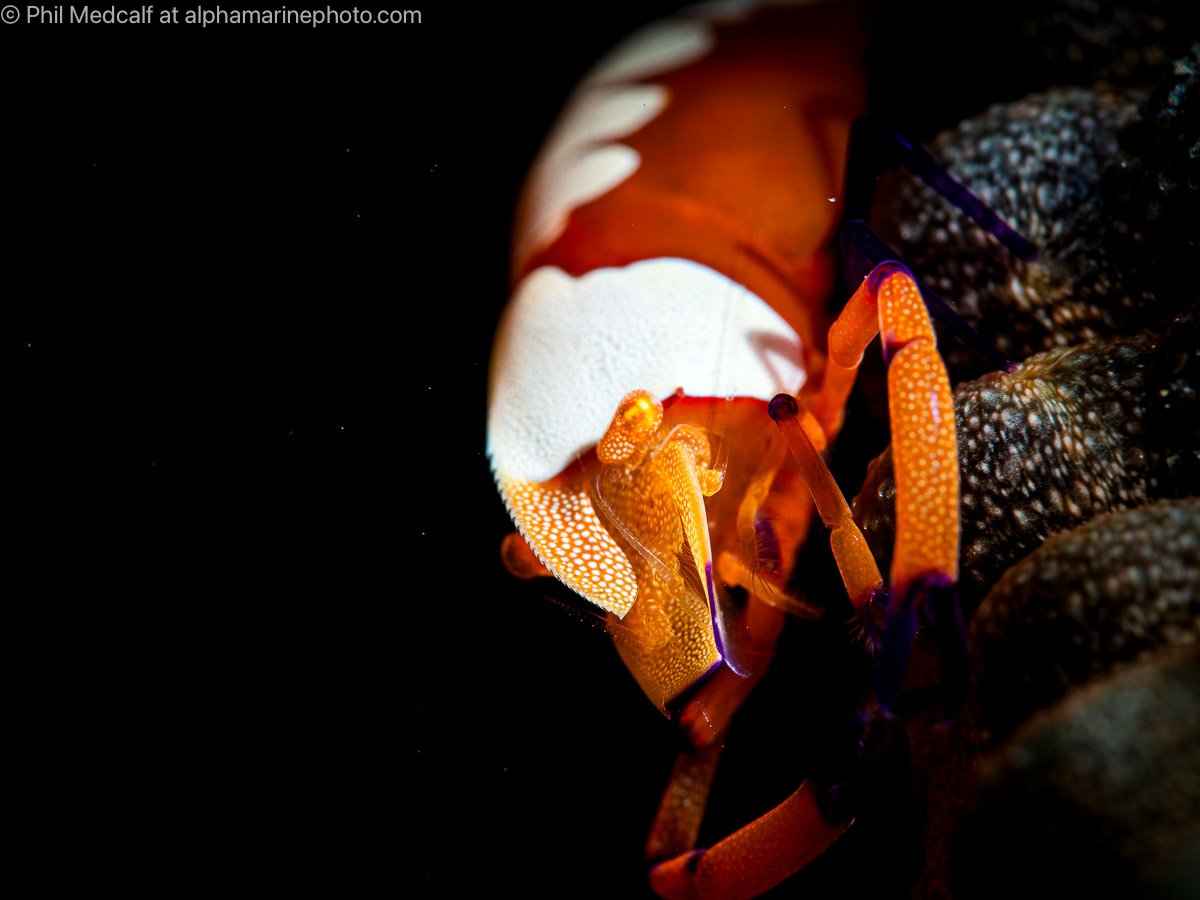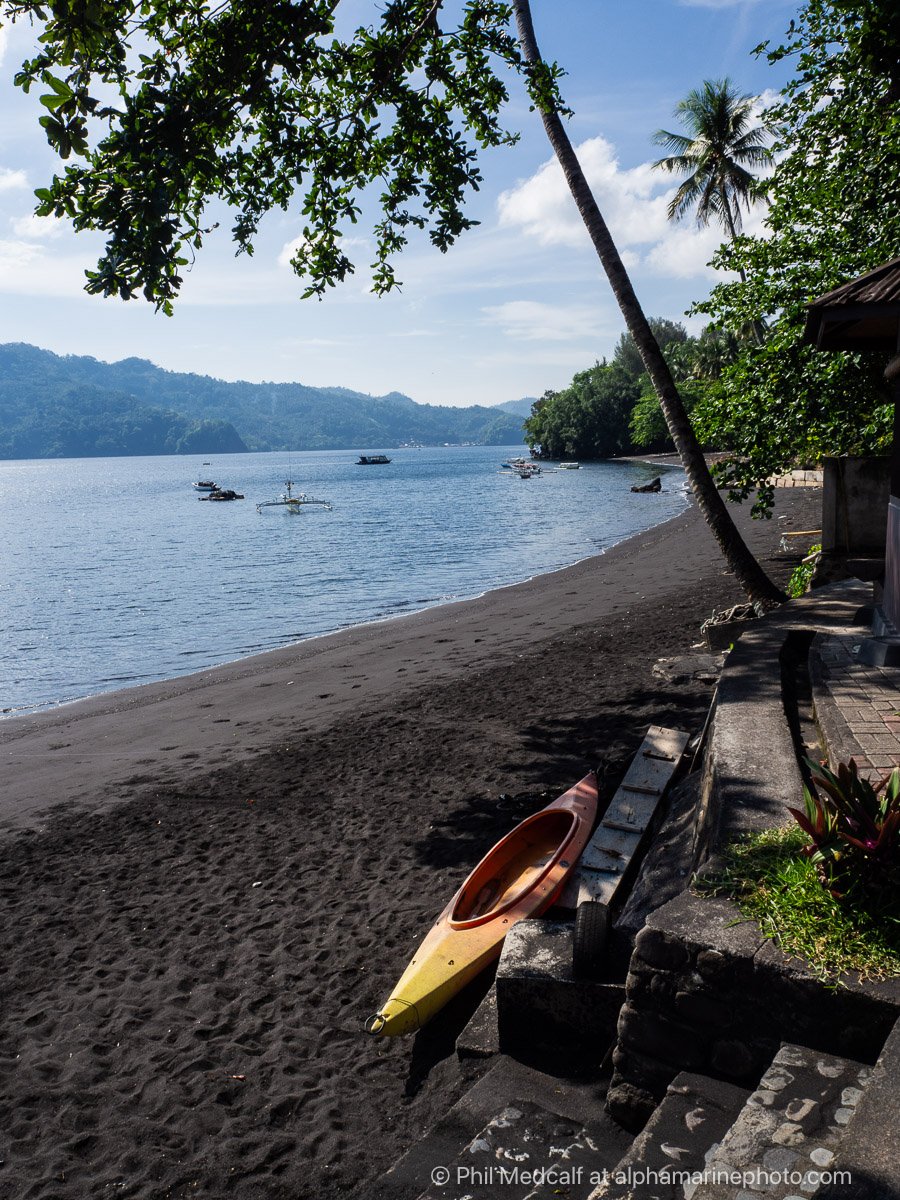In November last year we ran an underwater photography workshop at Dive Into Lembeh. The trip was arranged by our friends at Great Escapes Diving Holidays and we had a great group of eight people. Here’s a short report on how it went and what the resort and diving was like.
We did a 12 night stay with 11 days of diving, two boat dives per day with the option of diving unguided on the house reef included as well.
Guide ratio was between one and four divers depending on staff availability and whether any group members opted to take a dive off. The dive guides took great care of everybody, with the usual Indonesian talent for finding even the tiniest of creatures while creating a fun and friendly atmosphere.
Emperor shrimps living on large sea cucumbers are a fairly common sight on dives in the Lembeh Straits
The boats have a camera rinse tank, a covered area, drinking water and fruit to snack on after your dive. Entry is by giant stride rather than the more usual backward roll that lots of Lembeh dive boats require you to do. Distances to dive sites in the straits are quite short so we returned to the resort between all the dives.
The resort has a camera room with plenty of spaces to prepare your gear, power sockets for chargers, towels and air guns for drying equipment and two large rinse tanks.
Before each dive you placed your camera in a basket after checking it and your guide would put it on the boat ready for you. Your diving equipment is put on the boat and setup ready for you to check. All you need to do is put your suit on and bring your mask.
In the equipment area each person has a marked bay with a crate and hooks to put your gear on. There’s also an outside area to hang suits up.
Anemone porcelain crab on the underside of its anemone
The house reef is not a conventional coral reef like you might find in somewhere like the Red Sea but does have an array of soft and hard corals along with lots of anemones. This is bounded by black sand ‘muck’ diving, with particular hotspots of life around the mooring blocks.
The view across the beach at Dive Into Lembeh showing the straits and Lembeh Island in the background.
Because much of the diving is over soft black sand and there is a host of strange, camouflaged and often poisonous creatures living on and in it, it pays to be careful with your buoyancy.
The Lembeh Straits are heavily used and have a large city and several villages and towns so litter is a common sight. But much of it provides home for fish, crustaceans and sometimes octopus along with being a substrate for soft and hard corals.
The house reef at Dive Into Lembeh was home to an impressive number and variety of anemones and their resident anemonefish. This pink anemonefish (Amphiprion perideraion) is host to a tongue biter parasite.
In the evenings before dinner we would meet up for either a short talk by myself and Anne on an underwater photography subject, a relaxed discussion and review of some of our pictures from the day or on a couple of evenings a talk by one of the resort staff. Ben who is the Guest Relations Manager and resident photo pro at DIL went through some of his images one evening and on another Agus, one of the guides who is also a marine biologist did a talk about the reproductive cycles of marine creatures. On our last evening we did a talk to everyone at the resort showing a range of images from the trip and other parts of the world.
This mimic octopus was one of several species of cephalopod we encountered on the dives. Anne lit it using a Backscatter Mini Flash 2 strobe fitted with an optical snoot which as well as using ourselves was tried out by several of the workshop attendees along with other equipment we brought with us.
Food was excellent and mainly local style. The soups were particularly good. The resort also has a well stocked bar that does a good line in cocktails.
The grounds of the resort are home to a range of tropical birds, insects and lizards. We spent some time after dives sitting in the pool watching swallows skimming over the water.
The pool quickly became part of our post dive routine
Accommodation is in a choice of either bungalows or longhouse rooms. The longhouse has two twin rooms and one double, all of which have an ensuite bathroom. The nine bungalows are spacious and include Japanese-style Onsen hot tubs on their verandas. Whichever room you opt for they are all comfortable and have drinking water dispensers that give both hot and cold water.
We had an amazing trip and thanks to how well run the resort and diving were combined with the friendliness of everybody that made us feel like family, we immediately began planning a return trip. In November 2025 we’ll be back at Dive Into Lembeh if you would like to join us and we have another workshop there in 2026.
If you’d like to learn more about underwater photography as well as our Lembeh workshops we run others in the UK and overseas and online courses. Email us with any enquiries or use our contact form to get in touch and sign up to our newsletter.
We also run a Q and A group on Facebook which anyone is welcome to join if they obey the rules.
If you found this article useful, but are not planning to buy equipment from us or do a workshop you can give us your support though our ‘buy me a coffee’ page. Be aware that links to Wex, MPB or eBay listings are affiliate links and we get a small percentage if you buy something through them.








